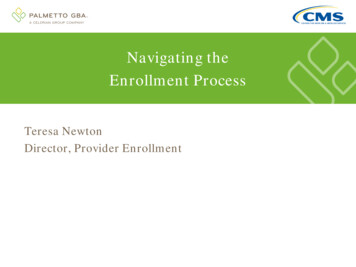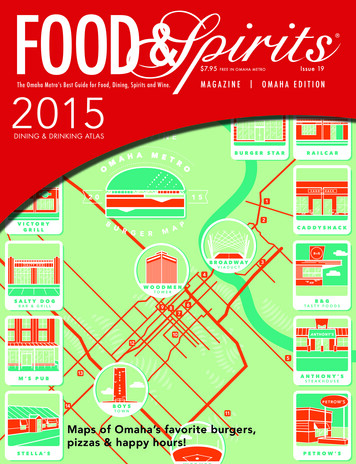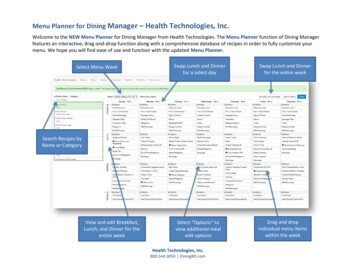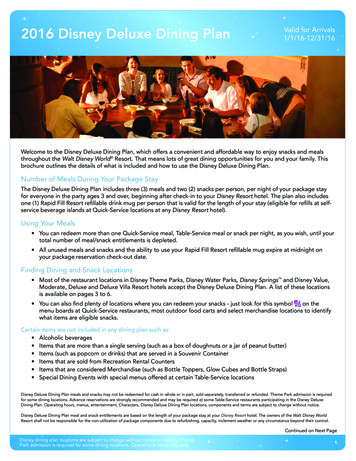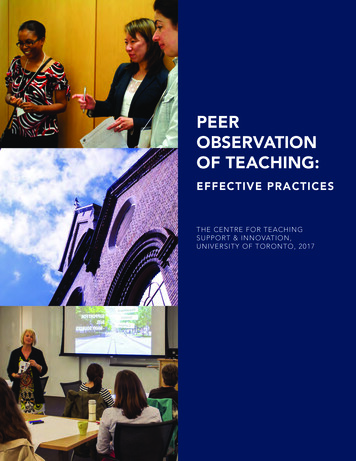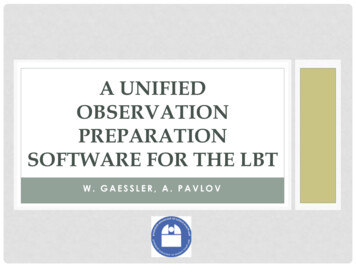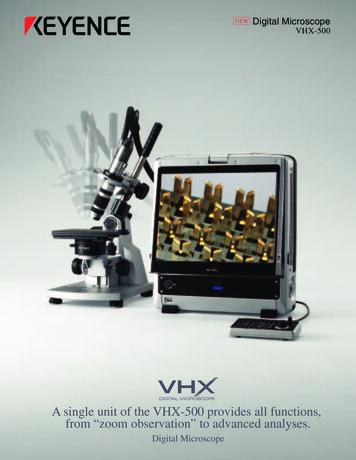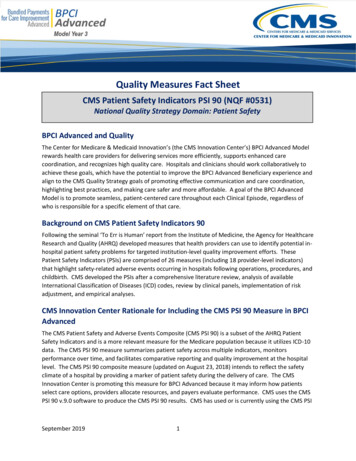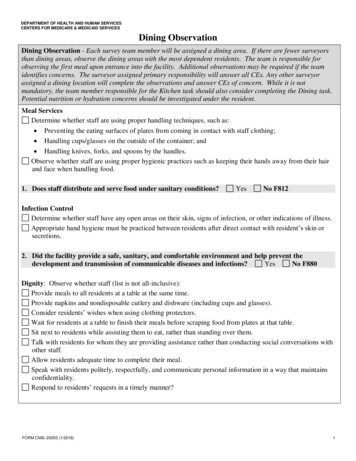
Transcription
DEPARTMENT OF HEALTH AND HUMAN SERVICESCENTERS FOR MEDICARE & MEDICAID SERVICESDining ObservationDining Observation - Each survey team member will be assigned a dining area. If there are fewer surveyorsthan dining areas, observe the dining areas with the most dependent residents. The team is responsible forobserving the first meal upon entrance into the facility. Additional observations may be required if the teamidentifies concerns. The surveyor assigned primary responsibility will answer all CEs. Any other surveyorassigned a dining location will complete the observations and answer CEs of concern. While it is notmandatory, the team member responsible for the Kitchen task should also consider completing the Dining task.Potential nutrition or hydration concerns should be investigated under the resident.Meal ServicesDetermine whether staff are using proper handling techniques, such as: Preventing the eating surfaces of plates from coming in contact with staff clothing; Handling cups/glasses on the outside of the container; and Handling knives, forks, and spoons by the handles.Observe whether staff are using proper hygienic practices such as keeping their hands away from their hairand face when handling food.1. Does staff distribute and serve food under sanitary conditions?YesNo F812Infection ControlDetermine whether staff have any open areas on their skin, signs of infection, or other indications of illness.Appropriate hand hygiene must be practiced between residents after direct contact with resident’s skin orsecretions.2. Did the facility provide a safe, sanitary, and comfortable environment and help prevent thedevelopment and transmission of communicable diseases and infections?YesNo F880Dignity: Observe whether staff (list is not all-inclusive):Provide meals to all residents at a table at the same time.Provide napkins and nondisposable cutlery and dishware (including cups and glasses).Consider residents’ wishes when using clothing protectors.Wait for residents at a table to finish their meals before scraping food from plates at that table.Sit next to residents while assisting them to eat, rather than standing over them.Talk with residents for whom they are providing assistance rather than conducting social conversations withother staff.Allow residents adequate time to complete their meal.Speak with residents politely, respectfully, and communicate personal information in a way that maintainsconfidentiality.Respond to residents’ requests in a timely manner?FORM CMS–20053 (1/2018)1
DEPARTMENT OF HEALTH AND HUMAN SERVICESCENTERS FOR MEDICARE & MEDICAID SERVICES3. Does the facility promote care for residents in a manner and in an environment that maintains orenhances each resident’s dignity and respect in full recognition of his or her individuality?YesNo F550Homelike Environment: A "homelike environment" is one that de-emphasizes the institutional character of thesetting, to the extent possible. A determination of "homelike" should include, whenever possible, the resident'sor representative of the resident's opinion of the living environment.Determine the presence of institutional practices that may interfere with the quality of the residents’ diningexperience, such as: Meals served on trays in a dining room; Medication administration practices that interfere with the quality of the residents’ dining experience.Note: Medication administration during meal service is not prohibited for: Medications that must be taken with a meal. Medication administration requested by a resident who is accustomed to taking the medication with ameal, as long as it has been determined that this practice does not interfere with the effectiveness ofthe medication.Has the facility attempted to provide medications at times and in a manner that does not distract from thedining experience of the resident, such as: Pain medications being given prior to meals so that meals can be eaten in comfort; Foods served are not routinely or unnecessarily used as vehicles to administer medications (mixing themedications with potatoes or other entrees)4. Did the facility provide a homelike dining environment?YesNo F584Resident Self-Determination or PreferencesDetermine staff response to a resident who refuses to go to the dining area, refuses the meal or meal itemsoffered, or requests a substitute. If concerns are identified, interview the resident to determine whether: The resident was involved in choosing when to eat; The resident was involved in choosing where to eat; and/or The food offered takes into account the resident’s food preferences.Interview staff regarding the facility protocol to identify where and when a resident eats, how staff knowswhether a specific resident eats in a specific dining room or other location, and how food preferences areidentified and submitted to the dietary department.5. Does the facility honor the resident’s right to make choices about aspects of his/her life in the facilitythat are significant to the resident?YesNo F561Dining AssistanceDetermine during the meal service, whether staff are providing services to meet the residents’ needs, such as: Provision of cueing, prompting, or assisting a resident to eat in order to improve, maintain, or preventthe decline in eating abilities; How meals and assistance to eat is provided to those residents who wish to eat in their rooms;FORM CMS–20053 (1/2018)2
DEPARTMENT OF HEALTH AND HUMAN SERVICESCENTERS FOR MEDICARE & MEDICAID SERVICES Staff availability and presence during the dining process; and Assistance to eat for residents who are dependent on staff.If residents are not receiving timely assistance to eat related to lack of sufficient nursing staff, review thisunder the Sufficient Nursing Staff task.6. Does the facility provide assistance with meals, assisting with hydration, and nutritional provisionsthroughout the day?YesNo F676 and/or F677Assistive DevicesDetermine during the meal service, whether staff are providing services to meet the residents’ needs, such as: Whether adaptive devices are provided to residents requiring them.7. Does the facility provide resident with assistive devices if needed?YesNo F810PositioningDetermine during the meal service, whether staff are providing services to meet the residents’ needs, such as: Proper positioning to maximize eating abilities (e.g., wheelchairs fit under tables so residents can accessfood without difficulty and residents are positioned in correct alignment).8. Is the resident positioned correctly to provide care and services that promote the highest practicalwell-being?YesNo F675Dietary NeedsDetermine during the meal service, whether staff are providing services to meet the residents’ needs, such as: How staff identify and meet residents’ special dietary requirements (e.g., allergies, intolerances, andpreferences).9. Are residents receiving food that accommodates resident allergies, intolerances, and preferences?YesNo F806Paid Feeding AssistantsIf you observe a resident who is being assisted by staff, and the resident is having problems eating ordrinking: Determine whether a paid feeding assistant is assisting the resident; Determine whether the paid feeding assistants are properly trained, adequately supervised, assisting onlythose residents without complicated feeding problems, and providing assistance in accordance with theresidents’ needs; and If the staff is not a paid feeding assistant, and if technique concerns are identified in the provision ofassistance by CNAs, initiate F727 Proficiency of Nurse Aides, for further review.FORM CMS–20053 (1/2018)3
DEPARTMENT OF HEALTH AND HUMAN SERVICESCENTERS FOR MEDICARE & MEDICAID SERVICES10. Are residents selected based on an IDT assessment? Are paid feeding assistants supervised or used inaccordance to State law?YesNo F811NA11. Have the paid feeding assistants completed a State-approved training program prior to working inthe facility?YesNo F948NAFood and Drink QualityIf concerns regarding palatability and/or appearance are identified, determine whether: Mechanically altered diets, such as pureed foods, were prepared and served as separate entree items,excluding combined foods such as stews, casseroles, etc.; and Food placement, colors, and textures were in keeping with the resident’s needs or deficits, such asresidents with vision or swallowing deficits.Interview residents to confirm or validate observations and to assess food and drink palatability andtemperature.If the team has identified concerns with food quality or residents complain about thepalatability/temperature of food or drink served, the survey team coordinator may request a test tray toobtain quantitative and qualitative data to assess the complaints.Send the meal to the unit that is the greatest distance from the kitchen or to the affected unit or dining room.Check food temperature and palatability of the test meal close to the time the last resident on the unit isserved and begins eating.12. Does the facility serve meals that conserve nutritive value, flavor, and appearance, and are palatable,attractive, and a safe and appetizing temperature (e.g., provide a variety of textures, colors,seasonings, pureed foods not combined)?YesNo F80413. Do the residents maintain acceptable parameters of nutritional status unless the resident’s clinicalcondition demonstrates that this is not possible or resident preferences indicate otherwise?YesNo F692Drinks and Other LiquidsAre drinks and other fluids provided when the resident requests and consistent with the resident’s care plan?Are the resident’s preferences honored when providing drinks and other fluids?14. Does the facility provide drinks including water and other liquids consistent with residents’ needsand preferences?YesNo F807Food Substitutes: If concerns are identified with a resident who is not consuming his/her meal or has refusedthe meal served:Determine whether staff attempt to determine the reason(s) for the refusal and offer a substitute item of equalnutritive value or another food item of the resident's choice.If staff do not offer an alternative item, interview the resident to determine whether he/she is provided asubstitution when he/she does not wish to have the item being served.FORM CMS–20053 (1/2018)4
DEPARTMENT OF HEALTH AND HUMAN SERVICESCENTERS FOR MEDICARE & MEDICAID SERVICESInterview staff in order to determine what is available for substitutes for the meal observed.15. Does the facility offer an appealing option of similar nutritive value to residents who refuse foodbeing served?YesNo F806Therapeutic DietsObserve residents to ensure they are being served a therapeutic diet, if prescribed.Review the residents’ records to ensure the resident is prescribed a therapeutic diet.Review additional information the dietary staff uses to identify those residents in need of a therapeutic diet(e.g., tray cards, dietary cards).16. Are residents receiving therapeutic diets as prescribed?YesNo F808LightingDetermine whether the dining areas are well lighted: Illumination levels are task-appropriate with little glare; Lighting supports maintenance of independent functioning and task performance; and Ask residents whether they feel the lighting is comfortable and adequate, and how the lighting affectstheir ability to eat.17. Does the facility provide one or more rooms designated for dining that are well lighted?YesNo F92018. Does the facility provide adequate and comfortable lighting levels in the dining areas?YesNo F584Ventilation: Determine whether the dining areas have:Efficient ventilation.Good air circulation.Acceptable temperature and humidity.Avoidance of drafts at the floor level.Adequate removal of smoke exhaust and odors.19. Does the facility provide one or more rooms designated for dining that is well ventilated?YesNo F920Sound Levels: Determine whether sound levels in dining areas interfere with social interaction during the mealservices. Consider the following:Residents or staff have to raise their voices to be heard.Residents can't be heard due to background noise.Residents have difficulty concentrating due to the background noise.FORM CMS–20053 (1/2018)5
DEPARTMENT OF HEALTH AND HUMAN SERVICESCENTERS FOR MEDICARE & MEDICAID SERVICESResidents have no control over unwanted noise.20. Does the facility provide comfortable sound levels in the dining areas?YesNo F584Comfortable and Safe Temperatures: Comfortable and safe temperature levels means that the ambienttemperature should be in a relatively narrow range that minimizes residents' susceptibility to loss of body heatand risk of hypothermia or susceptibility to respiratory ailments and colds.Observe whether residents complain of heat or cold in the dining areas.Observe what actions staff take in relation to complaints about the temperature levels in the dining areas.Interview staff to determine how the temperature levels are set and maintained.Ask staff what measures they take to address the issues related to temperatures out of the 71-81 degreeFahrenheit ( F) range.21. Does the facility maintain comfortable and safe temperature levels in the dining areas?YesNo F584Furnishings: An adequately furnished dining area accommodates different residents' physical and socialneeds.Observe table height to determine whether it provides the residents with easy visibility and access to food.Observe whether furnishings are structurally sound and functional (e.g., chairs of varying sizes to meetvarying needs of residents, wheelchairs can fit under the dining room table).22. Are the dining areas adequately furnished to meet residents’ physical and social needs?YesNo F920SpaceObserve whether the dining areas have sufficient space.Residents can enter and exit the dining room independently without staff needing to move other residentsout of the way.Residents could be moved from the dining room swiftly in the event of an emergency.Staff would be able to access and assist a resident who is experiencing an emergency, such as choking.There is no resident crowding.23. Do the dining areas have sufficient space to accommodate all dining activities?YesNo F920Frequency of MealsInterview residents and/or staff to determine how often meals are served beyond the posted serving times.If a concern is identified regarding the timing of a meal service, interview staff to identify how the mealservice is organized, times for meal availability, and how staff assures that a resident has received a meal.Interview the residents and staff to determine: What happens if they miss the allocated meal service time periods;FORM CMS–20053 (1/2018)6
DEPARTMENT OF HEALTH AND HUMAN SERVICESCENTERS FOR MEDICARE & MEDICAID SERVICES Whether snacks are available, types, and when available;If suitable, nourishing alternative meals and snacks are provided to residents who want to eat at nontraditional times or outside of scheduled meal service times, and they are consistent with the residents’plan of care.24. Does the facility provide at least three meals daily at regular times comparable to mealtimes in thecommunity or in accordance with residents’ needs?YesNo F80925. Does the facility provide sufficient staff to safely and effectively carry out the functions of the foodand nutrition services, including preparing and serving meals, in the scheduled time frames?YesNo F80226. Does the facility provide meals with no greater than a 14 hour lapse between the evening meal andbreakfast, or 16 hours with approval of a resident group and provision of a substantial eveningsnack?YesNo F809FORM CMS–20053 (1/2018)7
FORM CMS-20053 (1/2018) 1 Dining Observation - Each survey team member will be assigned a dining area. If there are fewer surveyors than dining areas, observe the dining areas with the most dependent residents. The team is responsible for observing the first meal upon entrance into the facility. Additional observations may be required if the team

